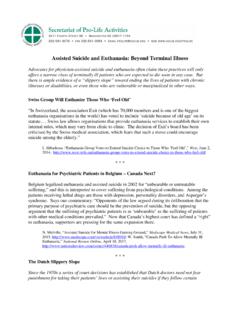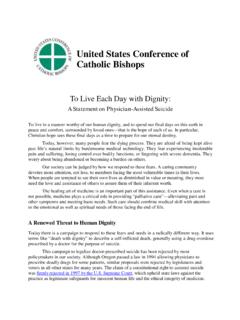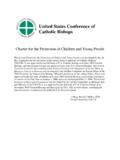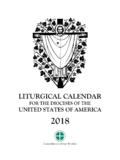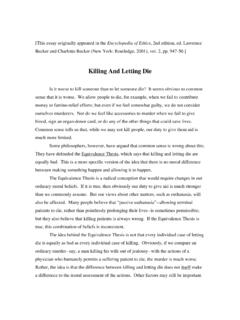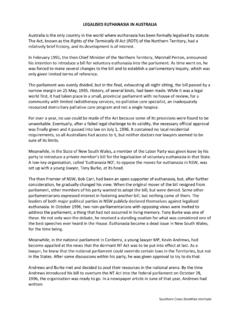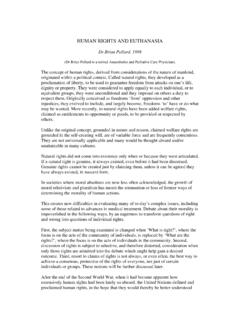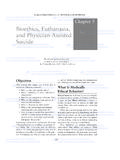Transcription of Assisted Suicide and Euthanasia: From Voluntary to …
1 Assisted Suicide and euthanasia : From Voluntary to Involuntary While promoted in the name of personal autonomy, physician- Assisted Suicide (providing lethal drugs so patients can take their own lives) and euthanasia (direct killing of patients by doctors) do not remain limited to cases in which the victim gave his or her Voluntary consent. This agenda ultimately embraces coercion and the death of unwilling The Case of the Netherlands Since 1973 a series of court decisions has established that Dutch doctors need not fear punishment or prosecution if they kill, or assist the suicides of, patients in unbearable suffering who make a Voluntary request to die. When the Dutch government studied actual practice in 1991, it found: 2300 cases of Voluntary euthanasia every year; 400 Assisted suicides; and 1040 cases in which doctors killed patients without their knowledge or consent.
2 In this last category, 72% of the patients had never expressed an interest in having their lives taken, and 14% were fully competent. In addition, 8100 patients died from overdoses of pain medications intended primarily to end life rather than relieve pain, and 61% of the time (4941 cases) this was done without the patient s consent. Patients Rights Council, Background About euthanasia in the Netherlands, at * * * In one recent case, A Dutch physician slipped a sedative into an elderly dementia patient s coffee after deciding it was time for her to receive euthanasia . When the patient awoke and struggled against what was being done, the doctor told the patient s family to hold her down while the lethal injection was administered. The doctor was cleared of any wrongdoing by a regional review committee, which said the doctor acted in good faith.
3 R. Roberts, Doctor who asked dementia patient's family to hold her down while she gave lethal injection cleared, The Independent (London), 5 February 2017, at * * * Writes one investigator into Dutch practice: Some euthanasia advocates defend the need for doctors to make decisions to end the lives of competent patients without discussion with them. One euthanasia advocate gave me as an example a case where a doctor had terminated the life of 1 On how Assisted Suicide laws in Oregon and Washington open the door to ending the life of people unable to give Voluntary and informed consent, also see USCCB Secretariat of Pro-Life Activities, Assisted Suicide Laws in Oregon and Washington: What Safeguards?, at 2 a nun a few days before she would have died because she was in excruciating pain, but her religious convictions did not permit her to ask for death.
4 He did not argue, however, when asked why she should not have been permitted to die in the way she Other advocates admit that a system in which doctors become used to playing a predominant role in making decisions about ending life encourages some to feel entitled to make decisions without consulting patients. H. Hendin, Assisted Suicide , euthanasia , and Suicide Prevention: The Implications of the Dutch Experience, Suicide & Life-Threatening Behavior 193-204 (Spring 1995) at 201-2. For other cases see R. Fenigsen, Other People s Lives: Reflections on Medicine, Ethics, and euthanasia , Issues in Law & Medicine 239-79 (Spring 2011) at 278. * * * While patients with clinical depression or other mental disorders cannot be expected to make a rational request for Assisted Suicide , in Oregon and Washington only 4% of patients receive a psychological evaluation to exclude such cases (see documentation in note 1 above).
5 In the Netherlands, Belgium and Switzerland, such mental illness can actually be the sole reason for a physically healthy patient to receive Assisted Suicide or euthanasia . A 2016 study reviewing 66 such cases in the Netherlands showed that most of the patients were women, most suffered from depression, and 35% had no independent psychiatric input or consultants had disagreed. B. Carey, Assisted Suicide Study Questions Its Use for Mentally Ill, The New York Times, Feb. 10, 2016, at ; S. Kim et al., euthanasia and Assisted Suicide of Patients With Psychiatric Disorders in the Netherlands 2011 to 2014, JAMA Psychiatry 362-8 (2016) at 362. * * * Newborn children, of course, cannot make a Voluntary request for euthanasia . Yet in 1993, a Dutch physician was acquitted of wrongdoing after he gave a lethal injection to a four-day-old infant with spina bifida, because he allegedly faced a conflict between his duties to preserve life and to relieve suffering.
6 By 1995, Dutch physicians had published an account of 22 similar cases. Parents had consented to the injections; however, in all but four cases it was the physicians who first made the proposal. That year the Dutch Association of Paediatrics approved the Groningen Protocol, which set standards for such nonvoluntary taking of life and found all 22 cases to be in accord with acceptable medical practice. T. De Jong, Deliberate termination of life of newborns with spina bifida, a critical reappraisal, 24 Child s Nervous System 13-28 (2008) at 15-17. Killing Without Consent in Belgium In Belgium, where Voluntary euthanasia was legalized with supposed safeguards in 2002, a 2010 study showed that half of nurses involved in the practice 120 out of 248 had taken the lives of patients without their request or consent. We should take a warning from this that 3 wherever you draw the line, people will go up to it and beyond it, said Dr.
7 Peter Saunders of Great Britain s Care Not Killing campaign. Once you have legalised Voluntary euthanasia , involuntary euthanasia will inevitably follow. S. Caldwell, Warning to Britain as almost half of Belgium s euthanasia nurses admit to killing without consent, in The Daily Mail (London), June 10, 2010, at . * * * In a study of 208 deaths in Belgium in 2007 involving the use of life-ending drugs, physicians reported that 66 of these deaths (about 32%) were without an explicit request. The study notes: Use of life-ending drugs without an explicit request mostly involved patients 80 years or older, those with a disease other than cancer and those in hospital. Of the deaths without an explicit request, the decision was not discussed with the patient in of cases. K. Chambaere et al., Physician- Assisted deaths under the euthanasia law in Belgium: a population-based survey, Canadian Medical Association Journal 895-901 (June 15, 2010) at 895, Children and euthanasia In 2014 Belgium became the first country to end age limits on euthanasia , extending the practice to terminally ill children of any age.
8 The first child killed under this policy died in 2016. Since 2002 the Netherlands has allowed euthanasia for children aged 12 or older; but in 2015, the Dutch Paediatricians Association began urging that the Netherlands follow Belgium in rejecting any such arbitrary age limit so younger children can request euthanasia . Y. Logghe, First child dies by legal euthanasia in Belgium, Associated Press, Sept. 19, 2016, at ; J. Huggler, Give children under 12 the right to die, say Dutch paediatricians, The Telegraph (London), June 19, 2015, at The Trend in the United States The Assisted Suicide movement in the United States, as well, has shown that this agenda will not be limited to cases where a Voluntary request is made by a competent patient. Criticizing the murder conviction of Richard Rodriguez, a man who said he had fatally shot his ailing and elderly father out of sympathy, the executive director of Hemlock Society USA (now renamed Compassion and Choices ) stated: A judicial determination should be made when it is necessary to hasten the death of an individual whether it be a demented parent, a suffering, severely disabled spouse or a child.
9 Consultants should evaluate what other ways might be used 4 to alleviate the suffering and, if none are available or are unsuccessful, a non-violent, gentle means should be available to end the person s life. Faye Girsh of Hemlock Society USA, Mercy Killing: A Position Statement Regarding Richard Rodriguez, PR Newswire, December 3, 1997, quoted in Patients Rights Council, IAETF Update ( 1998), * * * In 2014, Barbara Coombs Lee as president of Compassion & Choices reaffirmed this stand at a forum in Connecticut. Noting that current legislation in the does not cover patients with dementia or other conditions preventing an informed choice, she said: It is an issue for another day but is no less compelling. L. Foster, Compassion & Choices Draws Full House at Real Art Ways for Panel Discussion, Film, CT News Junkie, Oct.
10 10, 2014, at (emphasis added). * * * Writes the founder of the Hemlock Society: In attempting to answer Why Now?, one must look at the realities of the increasing cost of health care in an aging society, because in the final analysis, economics, not the quest for broadened individual liberties or increased autonomy, will drive Assisted Suicide to the plateau of acceptable Is there, in fact, a duty to die a responsibility within the family unit that should remain Voluntary but expected nevertheless? D. Humphry and M. Clement, Freedom to Die: People, Politics, and the Right-to-Die Movement (St. Martin s Press 1998) at 313 (emphasis added). * * * Oregon has taken steps toward an expected earlier death for patients whose care costs the government money. In 1995, Oregon s State Health Services Commission voted 10-to-1 to include physician- Assisted Suicide as a form of comfort care for all low-income terminally ill patients covered by Oregon s Medicaid rationing program.
